The new selected expedition was the definite decision of the British Admiralty how to solve the problem of the North West Passage. Sixty-years-old commander Sir John Franklin, an experienced man from that time of Napoleon’s wars and a polar explorer as well, was the leader of the new expedition. He was always brave and energetic , honourable and humane but during the last expedition he seemed to have been a bit hesitating and he often changed his mind. 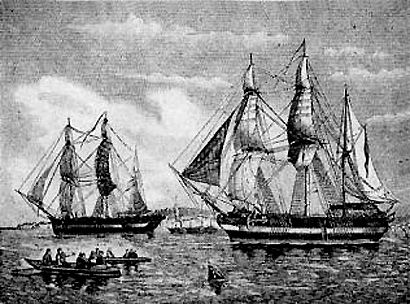
H.M. ships Erebus and Terror Nevertheless the two ships Erebus and Terror, carrying 128 well trained men and feed for three years, set out on the voyage from the Thames estuary in May 1845. Before departure Franklin’s wife put the British flag (that she embroidered herself) across her husband’s legs. But it was said that it had been for corpses covering and this story may have been his destiny... The crew was very optimistic, there was no doubt about the success of the expedition. Franklin reached the area in the north west next to Greenland. Here they received other food from a supplying ship that assumed to carry their mail for relatives at home. And that was all. For the next three years there has not been any report of this expensive expedition... 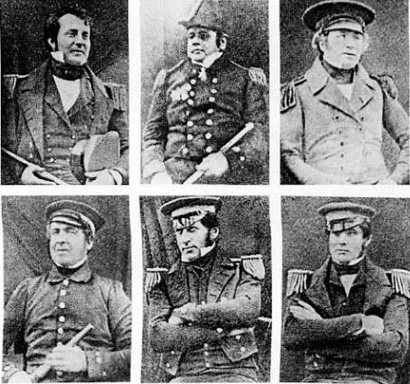
officers before sailing voyage from London 1845 The Admiralty worried about Franklin more and more. A new expedition under the command of J.C.Ross (the explorer of the North Magnetic Pole) set out on voyage to search Franklin. But where is Ross to begin. He spent winter in the Arctic and had re-turned under the criticism and with no success. The Admiralty resumed the search for the elite Franklin’s expedition because the British empire could not stand this loss. Thirteen vessels were looking for Franklin in the area of the Canadian Arctic in 1850. Big reward for Franklin’s rescue was offered. Franklin’s wife Lady Jane purchased Prince Albert boat to continue the search. But no evidence of the fate of Franklin’s expedition came to light. 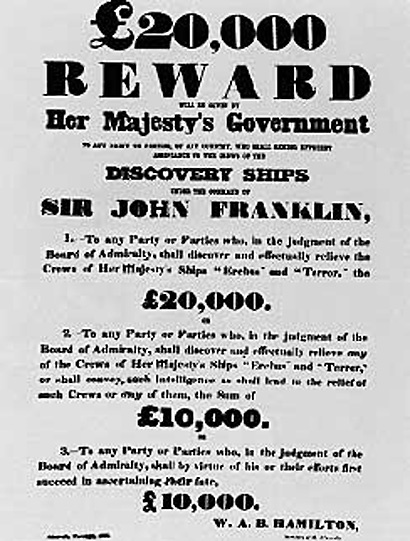
Her Majesty´s Government Reward - sir John Franklin In August the graves of three men were found on the small Beechey Island by captain Penney on his whaling ship. Ruins of stone chalet and plenty of cans were found as well. It was clear from the legends on the graves that those men died during the first winter (polar night) 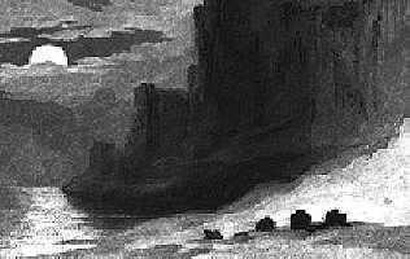
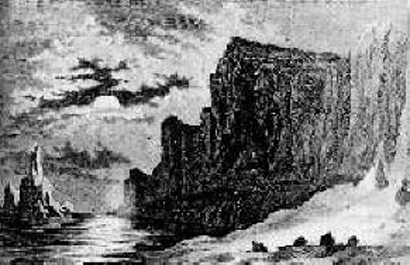
No message about Franklin’s intentions was found. After several years of intensive and expensive searching Franklin was missing. The Admiralty officially declared the men dead and intended to abandon the search. From the Rae’s report, based on what Eskimos saw, Terror had sunk near Adelaide island with dead men on the board and Erebus sunk near the area of the King William Island. The men who had survived, tried to get through the icy channel to the south. Later on The Eskimos found their remains near the Bachey river. Some of corpses were buried, some dead bodies were in tents or under boats. It was clear (from the remains of food) that cannibalism was the only way how to survive. The English government was shocked by the message but finally Dr.Rae was rewarded with 10 000 pounds for finding some evidence. 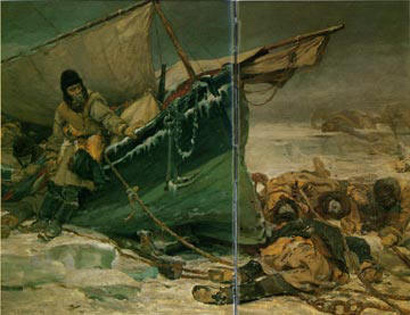
Franklin´s death (oil painting by W. Thomas Smith) Desperate Lady Jane offered all the property for a new expedition. In 1859 a grave mound with the message of the captain of Erebus was found. That was real evidence that the expedition wintered twice. 23 men died and Sir Franklin as well (1847). But nobody knew where and why. In 1980 remains of the Breadalbane boat, that also searched for Franklin, was discovered by Sonar on the sea bottom near Beechey Island. The exhumation of three dead men found on Beechey Island was done by anthropologist A.Beattie in 1984. Well pre-served bodies had been frozen in ice for 139 years. Scurvy and wounds were not supposed to appear but there was a possibility of poisoning because of the amount of lead in the bodies. Disappearance of the Franklin’s expedition had not been clarified till now. But it is paradoxical that the search for Franklin contributed to the discovery of the north more than ever before. There were more than 30 expeditions in the Arctic. But at what price translation: Dr. Pavel Kriz
• Beattie Owen, Geiger John: Buried in Ice, 1992
• Cyriax R.J.: Sir John Franklin´s Last Arctic Expedition, London 1939
• Davis, C.H.: Narrative of the North Polar Expedition. U.S. Ship Polaris, Captain Charles Francis Hall Commanding. Ed. G.M. Robeson, Washington 1876
• Evans E.: British Polar Explorers, London 1946
• Huish, Robert: The North-West Passage, London 1851
• Kane, E.K.: The Second Grinnell Expedition in Search of Sir John Franklin, 1853,'54,'55. Philadelphia, London 1857
• Kirwan L.P.: History of Polar Exploration, London 1962
• McClintok L.: A Narrative of the Discovery of the Fate of Sir John Franklin, London 1859
• Neatby L.H.: Search for Franklin, New York 1971
• Shillinglaw, John Joseph: A narrative of Arctic discovery, from the earliest period to the present time, London 1850
• Simmonds, Peter Lund: Sir John Franklin and the Arctic regions, London 1851
• Stefansson: Unsolved Mysteries of the Arctic, New York 1945
• Wonders W.: Search for Franklin, Canadian Geographical Journal 1967
• Wright N.: Quest for Franklin, London 1959 • Scott Polar Research Institute, Cambridge
. National Maritime Museum, London
• University of Alberta-Department of Anthropology, Edmonton, Alberta
• Westminster Abbey, London (pomník John Franklin)
THE DISAPPEARANCE OF FRANKLIN´S EXPEDITIONVladimir Vojir´s text corrected by Optomen Television (UK)
In The Disappearance of Franklin’s Expedition, we explore new revelations about a 150-year-old mystery. In 1845, the experienced, yet unstable Sir John Franklin set off in search of the North West Passage; a potentially invaluable trade route to Asia. Three years later, the first of many expeditions set out in search of the missing crew. A number of graves were eventually found, and testimonies from local Inuit revealed indisputable evidence of cannibalism. However, Franklin’s body, along with the expedition’s logs, have never been found. In 1993, an expedition led by Dr. Peter Wadhams discovered a lifeboat on Prince William Island - an area previously ignored by researchers. In a new expedition, Wadhams hopes to excavate the ship and find the missing pieces to this fascinating puzzle.
In May 1845 Sir John Franklin set off in a bold new effort to search for the North West Passage. His two boats - the Erebus and Terror - carried 128 well-trained men, and enough supplies for 3 years. A brave and experienced explorer, he’d been enlisted by the British Admiralty to lead this vital new expedition due to a rapidly increasing demand for a direct trade route to Asia. At the age of 60, however, Franklin was becoming a little hesitant and unsure of himself. Even so, his crew were optimistic and they successfully reached an area to the north west of Greenland where they received supplies and mail from relatives. This was the last time that anyone heard from them, and the details of their fate still remain a mystery to this day. After three years of waiting with no news, the British Admiralty and Franklin’s wife became desperately worried and sent out the first of many search expeditions. A huge reward was offered for anyone who returned with news, but by 1850 still no evidence had been found. Finally in August 1850, the Captain of a whaling ship discovered three graves on Beechey Island. He also found the ruins of a house and it was clear that the men had spent the first winter there. Another expedition, led by Dr. Rae in 1854, learnt something of the fate of the crew from the local Inuit. In a sequence of disasters, one of the boats had sunk and the other had been forced ashore by ice. In April 1848 the surviving crew had abandoned their camp and headed south. Their exposed corpses were later discovered by the Inuit at Bachey River, and it was clear from the discarded body parts that they’d resorted to cannibalism. Later, in 1859, a new expedition funded by Franklin’s wife discovered the grave of Captain Crozier of the Terror, on King William Island. A message found there stated that Franklin and 23 other men were dead, but no one knew why or where they were. The remains of these men and the two original ships have never been found, and other than the brief message found on King William Island, all records and logs of the crew’s journey are missing. However, dramatic new evidence has emerged which may reveal the true outcome of the Franklin expedition. In recent years, many search parties have scoured the areas that Franklin’s expedition covered - from Beechey Island in the North to the Adelaide Penisula to the south of King William Island. One of these search parties, led by Dr. Peter Wadhams (former head of the Scott Polar Institute), went to Prince William Island in 1993 to investigate a shipwreck found by local Inuit. Until then, the island had been ignored, as the early searches for Franklin found that the route to the island was impassable. However, the wreck found there resembles the lifeboats carried by Erebus and Terror, and this could throw new light on the Franklin story. Dr. Wadhams believes that some of the crew must have realised the trip south was pointless, and in warmer weather, headed north in a lifeboat back towards Beechey Island. There, food was abundant and rescue far more likely. Unfortunately, it seems they became trapped on Prince William Island, and tragically never made it… Vladimir VOJIR |
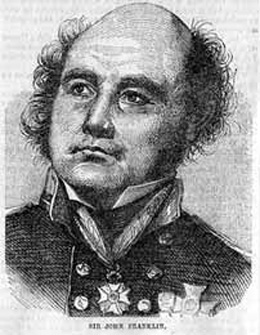
sir John Franklin
(1786 - 1847 nezvěstný) 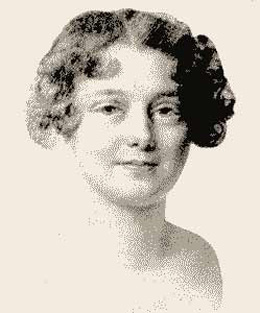
Jane - druhá žena Johna Franklina
(1791 - 1875) 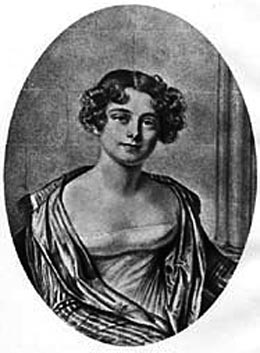
Jane - druhá žena Johna Franklina
(1791 - 1875) 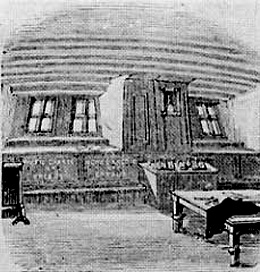
Franklinova kajuta na Erebu 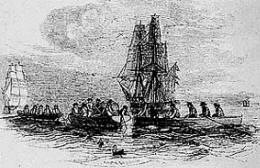
meetings ships Erebus and Terroron the high seas 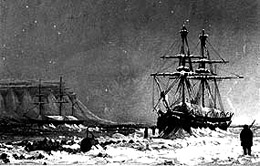
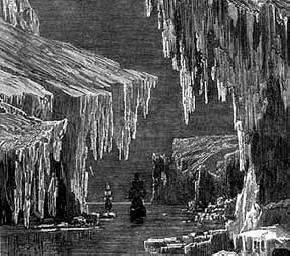
Erebus a Terror v ledové pasti 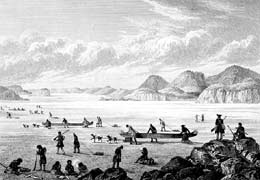
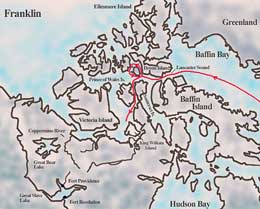
cesta lodí Erebus a Terror 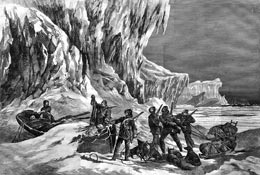
objevení pozůstatků Franklinovy
výpravy na ostrově Krále Williama 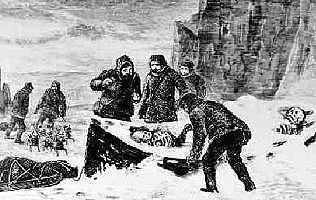
pozůstatky Franklinovy výpravy
objevené McClintokem pátrací lodě Enterprise a Investigator
(1848) 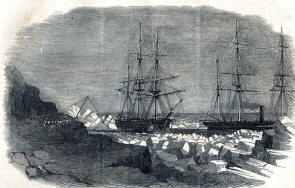
pátrací lodě Phoenix a Breadalbane
u mysu Riley (1853) 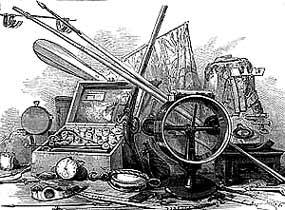
remains found items
Franklin's expedition (1854) 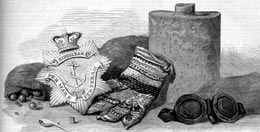
pozůstatky nalezených předmětů
Franklinovy výpravy (1854) 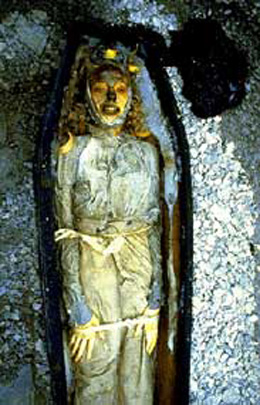
tělo Johna Torringtona z posádky
Terroru exhumované po 139 letech na
Beecheyho ostrově Dr. Beattiem
(1981) 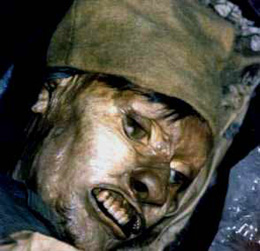
John Hartnell z posádky Erebu
exhumovaný Dr. Beattiem (1981) 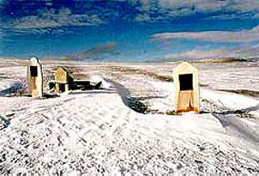
dva ze tří hrobů členů Franklinovy
výpravy na Beecheyho ostrově dnes 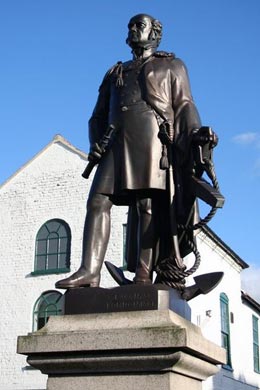
socha Johna Franklina v jeho rodném městě - Spilsby |